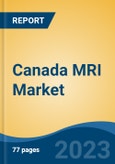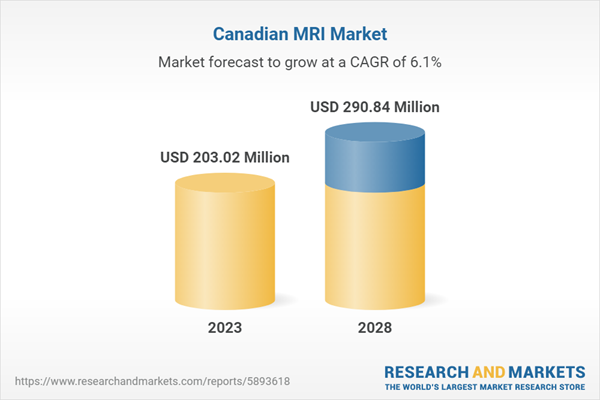Speak directly to the analyst to clarify any post sales queries you may have.
10% Free customizationThis report comes with 10% free customization, enabling you to add data that meets your specific business needs.
Increasing Prevalence of Chronic Diseases
The increasing prevalence of chronic diseases is a significant driver of the MRI (Magnetic Resonance Imaging) market in Canada. Chronic diseases, such as cancer, cardiovascular diseases, and neurological disorders, often require advanced diagnostic imaging tools like MRI to accurately diagnose and monitor the disease. MRI is particularly useful in detecting and monitoring the progression of chronic diseases and can help physicians make informed decisions about treatment options. As the incidence of chronic diseases continues to rise in Canada, the demand for advanced diagnostic imaging technologies like MRI is likely to grow. This is because MRI provides high-quality images of the internal structures of the body, which is essential in diagnosing and monitoring chronic diseases accurately. Moreover, as the Canadian population ages, the prevalence of chronic diseases is likely to increase further, creating a greater need for MRI technology. MRI is particularly useful in diagnosing age-related conditions, such as arthritis and dementia, which are more prevalent in older adults.Growing Aging Population
The growing aging population in Canada is a significant driver of the MRI (Magnetic Resonance Imaging) market in the country. As the population ages, the incidence of age-related diseases such as arthritis, dementia, and cancer increase. These conditions often require advanced diagnostic imaging technologies like MRI to accurately diagnose and monitor the disease. MRI is particularly useful in diagnosing and monitoring age-related conditions. For instance, MRI can be used to detect and track the progression of osteoarthritis, a common joint disease that affects older adults. Moreover, MRI can be used to diagnose and monitor dementia, a group of conditions that affect brain function and are more prevalent in older adults. As the Canadian population continues to age, the demand for MRI technology is likely to grow. This is because MRI is an essential diagnostic tool for age-related conditions and can help physicians make informed decisions about treatment options. Moreover, as the aging population grows, the demand for healthcare services is likely to increase, driving the demand for MRI machines and related services.Technological Advancements
Technological advancements are a significant driver of the MRI (Magnetic Resonance Imaging) market in Canada. As MRI technology continues to evolve, newer machines offer improved diagnostic capabilities, faster scan times, and higher resolution images. Technological advancements in MRI have led to the development of machines with improved diagnostic capabilities. These machines can provide more detailed and accurate images of the internal structures of the body, enabling physicians to make more informed diagnoses and treatment decisions. Technological advancements have also led to the development of MRI machines with faster scan times. This has several benefits, including reduced wait times for patients and increased efficiency in healthcare delivery. Newer MRI machines also offer higher resolution images, which can improve the accuracy of diagnoses and reduce the need for additional diagnostic tests. Technological advancements in MRI have led to the development of machines that are more comfortable for patients. For instance, newer machines are quieter and have more open designs, reducing the feeling of claustrophobia that some patients experience during the scan. Technological advancements have also led to the development of MRI machines that are more cost-effective. This can increase access to advanced diagnostic imaging technology, particularly in rural and remote areas.Government Initiatives
Government initiatives are a significant driver of the MRI market in Canada. The Canadian government has taken several initiatives to improve access to MRI technology and support the growth of the market. The Canadian government has made significant investments in healthcare infrastructure, including the development of new hospitals and clinics. These facilities often include advanced diagnostic imaging technologies like MRI, which can improve healthcare outcomes and drive demand for MRI machines. The Canadian government provides funding for research and development of new MRI technologies. This support has led to the development of new machines with improved capabilities, which can drive demand for newer and more advanced machines. The Canadian government has established regulations and standards for the use of MRI technology in healthcare. These regulations ensure that MRI machines meet certain safety and performance standards, which can improve the quality of care and increase patient confidence in the technology. The Canadian government has established reimbursement policies that provide financial support for MRI services. This support can increase access to MRI technology, particularly for patients who may not be able to afford the cost of the scan. The Canadian government conducts health technology assessments to evaluate the effectiveness and cost-effectiveness of new medical technologies, including MRI. These assessments can provide valuable information for healthcare providers and policymakers when making decisions about investing in new technology.Increasing Healthcare Expenditure
Increasing healthcare expenditure is a significant driver of the market in Canada. As healthcare expenditure increases, healthcare providers can invest in advanced diagnostic imaging technologies like MRI, driving the demand for MRI machines and related services. As healthcare expenditure increases, the demand for healthcare services is likely to grow. This can drive demand for advanced diagnostic imaging technologies like MRI as healthcare providers seek to provide better healthcare services to patients. Increasing healthcare expenditure can also lead to investments in healthcare infrastructure, including the development of new hospitals and clinics. These facilities often include advanced diagnostic imaging technologies like MRI, which can drive demand for newer and more advanced machines. Increasing healthcare expenditure can also improve access to MRI services, particularly for patients who may not be able to afford the cost of the scan. This can drive demand for MRI services and increase the utilization of MRI machines. Increasing healthcare expenditure can also lead to growing private sector investment in healthcare. This can drive demand for advanced diagnostic imaging technologies like MRI, as private healthcare providers seek to offer more comprehensive healthcare services. Increasing healthcare expenditure can also support research and development of new MRI technologies. This can lead to the development of newer and more advanced MRI machines with improved diagnostic capabilities, which can drive demand for newer machines.Market Segmentation
Canada MRI market can be segmented by field strength, type, architecture, application, end user, and region. Based on field strength, Canada MRI market can be segmented into high-field MRI systems (1.5t MRI systems, 3t MRI systems), low-to-mid-field MRI systems (< 1.5t), and very-high-field MRI systems (4t and above). Based on type, Canada MRI market can be divided into fixed and mobile. Based on architecture, Canada MRI market can be divided into closed MRI systems and open MRI systems. Based on application, Canada MRI market can be segmented into cancer brain and neurological, oncology, spine and musculoskeletal, abdominal, cardiac, and others. Based on end user, Canada MRI market can be segmented into hospitals, imaging centers, ambulatory surgical centers, and others.Market Players
GE Healthcare Canada Inc, Philips Canada Ltd., Siemens Healthcare Diagnostics Ltd/Canada, Canon Medical Systems Corp, Hitachi Solutions Canada Ltd, Hologic Inc, and Aurora Imaging Technology Inc are some of the leading players operating in the Canada MRI market.Report Scope:
In this report, the Canada MRI market has been segmented into the following categories, in addition to the industry trends which have also been detailed below:Canada MRI Market, By Field Strength:
- High-Field MRI Systems (1.5t MRI Systems, 3t MRI Systems)
- Low-To-Mid-Field MRI Systems (< 1.5t)
- Very-High-Field MRI Systems (4t and above)
Canada MRI Market, By Type:
- Fixed
- Mobile
Canada MRI Market, By Architecture:
- Closed MRI Systems
- Open MRI Systems
Canada MRI Market, By Application:
- Brain and Neurological
- Oncology
- Spine and Musculoskeletal
- Abdominal
- Cardiac
- Others
Canada MRI Market, By End User:
- Hospitals
- Imaging Centers
- Ambulatory Surgical Centers
- Others
Canada MRI Market, By Region:
- Ontario
- Quebec
- Alberta
- British Columbia
- Saskatchewan and Manitoba
- Rest of Canada
Competitive Landscape
Company Profiles: Detailed analysis of the major companies present Canada MRI Market.Available Customizations:
With the given market data, the publisher offers customizations according to a company’s specific needs.This product will be delivered within 1-3 business days.
Table of Contents
Companies Mentioned
- GE Healthcare Canada Inc
- Philips Canada Ltd.
- Siemens Healthcare Diagnostics Ltd/Canada
- Canon Medical Systems Corp
- Hitachi Solutions Canada Ltd
- Hologic Inc
- Aurora Imaging Technology Inc
Table Information
| Report Attribute | Details |
|---|---|
| No. of Pages | 77 |
| Published | October 2023 |
| Forecast Period | 2023 - 2028 |
| Estimated Market Value ( USD | $ 203.02 Million |
| Forecasted Market Value ( USD | $ 290.84 Million |
| Compound Annual Growth Rate | 6.1% |
| Regions Covered | Canada |
| No. of Companies Mentioned | 7 |









